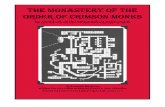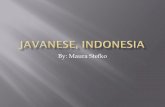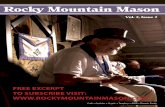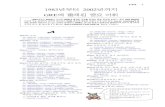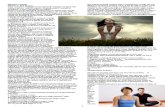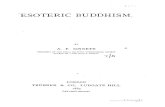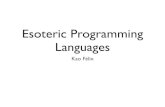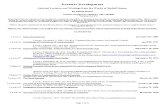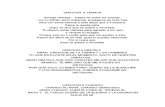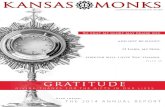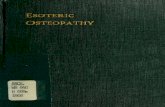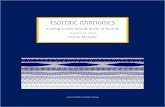The Wilderness Monks of the Abhayagirivihāra and the Origins of Sino-Javanese Esoteric Buddhism
Transcript of The Wilderness Monks of the Abhayagirivihāra and the Origins of Sino-Javanese Esoteric Buddhism

JEFFREY ROGER SUNDBERG
The wilderness monks of theAbhayagirivihara and the origins of
Sino-Javanese esoteric Buddhism
Introduction to the problem
Abandoned for a millennium,1 the smashed Siddhamatrka2 inscription com-memorating the foundation of a Javanese branch of the famous Sinhalesemonastery named Abhayagirivihara received mention in the earliest architec-tural exploration of the ruins of Javanese antiquity. First noticed in 1814, it wasrecovered bit by bit in the Dutch archaeological excavations of the late nine-teenth and the early twentieth century. It surfaced briefly in an examinationof the inscription of Kelurak by Bosch, and was then treated more fully by DeCasparis in an incremental series of revelations of the text which he had man-aged to decipher.3 The published portions of the text, however, do not reflectthe full extent of known fragments, and the inscription has not yet divulgedall of its mysteries. This article is an effort to tease out one of them.
1 As a preface to this essay, I wish to offer a word of thanks to Professor Raghu Vira and hisfamily, whose ambitious Sata-Pitaka Series is the source of a scholarly Indological feast and hashelped to recover memories of a lost world. I am grateful to John Banks, the Reverend MahindaDeegalle, Nobumi Iyanaga, Roy Jordaan, Lokesh Chandra, Mark Long, Iain Sinclair, DavidSnellgrove, and the two necessarily anonymous Bijdragen referees for advice and assistancewith this article.2 This script is sometimes referred to as prae-nagari, especially in the earlier Dutch archaeo-logical literature. The proper term for this script is siddamatrka, as Bosch (1928:4) clarifies in hispaleographic discussion of the script.3 The readings published to date are to be found in Bosch 1928:63-4 (given that Bosch accom-plished minor miracles with his painstaking work on the inscrutable Kelurak inscription, hiswork is a surprisingly sporadic transliteration of the comparatively highly legible four frag-ments then in the National Museum under the catalogue number D50, accompanied by a usablephotograph of them), De Casparis 1950:11-22 (a rather complete, annotated reading of the fiveparts now in the National Museum under the number D50), De Casparis 1961 (providing a few
JEFFREY ROGER SUNDBERG, who graduated from the University of Illinois at Urbana-Champaignand from the University of Southern California, is an electrical engineer. He is a specialist inVLSI design and high-speed signal integrity. His address is: 2601 W. Broadway Blvd, Tucson,AZ 85745-1787, USA.
. Bijdragen tot de Taal-, Land- en Volkenkunde (BKI) 160-1 (2004):95-123© 2004 Koninklijk Instituut voor Taal-, Land- en Volkenkunde

96 Jeffrey Roger Sundberg
De Casparis in his capacity as head of epigraphy for the NetherlandsArchaeological Service has provided the primary readings of the inscription,and his transcription has been published in three partial recensions. His 1961article, based on fragments found during the 1954 excavation season on theRatu Baka, gets to the heart of the matter of why this Sailendra inscriptionwas issued: the inscription commemorates the founding of a branch of theAbhayagirivihara of the Sinhalese, documenting their existence on line 11of the twelfth strophe with the words jinavaravinayoktaih Siksitanam ... <ya>tlnam abhayagirivihahrah karitah sinhalanam, translated by De Casparis (1961:245) as 'This Abhayagirivihara here of the Sinhalese ascetics, trained in thesayings of discipline of the Best of the Jinas, was established'. De Casparisalso helpfully determined that this inscription was written in AD 792.
As I intend to substantiate, there is epigraphical, historiographical, as wellas paleographical evidence to connect the Sinhalese, and particularly the 'wil-derness' monks associated with the Abhayagirivihara, with the diffusion of theYoga Tantras to recipient kingdoms and cultures in Java, China, and Japan.
The evidence to be evaluated forms circular and interconnecting associa-tions. It is difficult to determine where to begin, but as the focus of this articleis Java, let us begin with the chronological end, with the discovery of theinscription on the Ratu Baka plateau.
Identification of the Abhayagirivihara on the Ratu Baka plateau
Both the location of the finding of the Abhayagirivihara inscription as wellas the architectural details of a feature on the southeastern portion of theRatu Baka plateau suggest that the buildings of the Abhayagirivihara are tobe found there.
The find-spot of the inscription is something of a mystery as the frag-ments of the inscription have been found piece by piece at various times,but the preponderance of the clear archaeological evidence suggests that itsprovenance is the area around the feature described as a 'pendopo' on thesoutheast of the plateau. For orientation see Figure 1.
fragmentary readings of the key finds from the then newly-found 1954 pieces) and De Casparis1981:73-4 (a complete but slightly faulty transliteration and translation of the first three stanzas,the only complete stanzas allowed by the presently known fragments). The attentive studentwill note that some of De Casparis's published transliterations vary from recension to recension.Sarkar (1971:48i-48vii) has republished De Casparis's 1950-1961 transliterations, but has mislo-cated many of the newer De Casparis readings (his transcription is thus wrong in many details)and his translation should be treated with substantial wariness, especially the last ten lines of theinscription. Lokesh Chandra (1995:10-8) has provided a more cogent translation of the first threestanzas as given by De Casparis's 1981 transcriptions and added a substantial explication of theimagery. I intend to publish a more complete transcription and study on a later occasion.

The wilderness monks of the Abhayagirivihara 97
0 50 m
To the Dawangsari stupas
Figure 1. Raru Baka plateau. Adapted from Dumarc,ay (1993:185).
We have a reference to the Abhayagirivihara inscription in the earliestarchaeological description of Java, that of Crawfurd, Raffles's agent, thank-fully rescued from dusty libraries and republished by Bernet-Kempers (1949:177-93). When Crawfurd first ascended the Ratu Baka, the entire plateau wasengulfed in thick vegetation which required clearing before even the roughestimpressions of its nature could be obtained. After burning and destroying thegrass and trees, Crawfurd found a terrace 68 feet square and four feet high.This terrace was surrounded at a distance of 14 feet by a wall 11 feet high. Inthis construction there were four doors,4 one on each side, facing the cardinaldirections (Crawfurd had used a mariner's compass). Crawfurd notes:
4 This mention of four doors is seemingly an error on Crawfurd's part: the pendopo hasonly three doors, to the north, the west, and the south. It is clear that he is discussing the pen-dopo, however; the description matches no other feature on the plateau, and the mention of theinscription accords rather well with the other of its documented discoveries.

98 Jeffrey Roger Sundberg
On top of the terrace in two situations, are seen some loose blocks of stone whichappear to have constituted the elevated foundation of the sheds, which theJavanese I believe in imitation of the Hindus term Pendapa or Mandapa. Dr. Tytlerwho accompanied me in one of my last excursions to Prambanan, discovered inthe largest of the two piles of stone on the terrace a fragment of a slab of stone onwhich was a Deva Nagari inscription, and a little way to the south of the build-ing a mutilated stone figure which I imagine to represent Mahadewa destroyingTripurasura. (Bernet-Kempers 1949:185-6.)
Although many more fragments, presently totalling ten, are now known to usthan that seen by Crawfurd in the centre of the rubble-pile of the 'pendopo',his report is significant to us because, as we will shortly see, the earliest sight-ing of this Abhayagirivihara inscription places it directly in the centre of abuilding which has telltale architectural characteristics that associate it withsome of the meditation monasteries outside the parent Abhayagiriviharamonastery located in Anuradhapura in north-central Sri Lanka.
However, before we attribute the Abhayagirivihara inscription to thisparticular building on the basis of Crawfurd's description, we should keepin mind that others of the fragments were found outside the formal walls ofthe pendopo, in two instances rather far away from it if the archaeologicalreports are to be trusted. While two fragments, those denoted by Bosch asfragments 'a' and 'b',5 were found in 1886 by IJzerman near the ring wall ofthe so-called 'palace',6 two more fragments were found sometime before 1915by Rothe, who discovered them 'close to the restoration of the gate-build-ing' (De Casparis, 1950:11). There was a fifth, spearhead-shaped fragment,designated 'e', which was known to De Casparis in 1950 but not to Bosch in1928, and this latter piece is likely to have been one of the wartime's poorlycatalogued finds. However, the origins of the 1954 fragments, the first toreceive proper professional archaeological documentation, show clearly thatthe newer, Yogyakarta fragments were unearthed not very many metres atall from the southeast corner of the pendopo. Thus on balance we can feel
5 The inscription is at present divided into two parts. The five parts that had surfaced beforeIndonesian independence are now in the storeroom of the National Museum. Bosch's photo-graph depicts four of these which he labels 'a' to 'd', while the fifth fragment, 'e', was read byDe Casparis and documented in his 1950 book. The 1954 excavation season turned up five morefragments, which are now in the building of the Suaka Peninggalan Sejarah dan Purbakala of theSpecial District of Yogyakarta, Bogem. I thus refer to 'Museum' and 'Yogyakarta' portions of theinscription. Portions of these new fragments are presented by De Casparis in his 1961 and 1981:73-4 publications. Although approximately the lower middle sixth of the inscription presumablystill remains to be found on the Ratu Baka plateau, it would be desirable if the Museum andYogyakarta fragments could be reunited under the conservancy of the National Museum and aprominent place arranged for public display.6 IJzerman's 1886 findings were likely uncovered in the same position, just outside the east-ern side of the ring wall, as the 1954 findings.

The wilderness monks of the Abhayagirivihara 99
confident in saying that this inscription was associated with the pendopo asillustrated in the map.
This pendopo is somewhat remarkable in shape and layout. Two plat-forms, one square and one rectangular, are raised about 1.4 metres high andjoined together by a narrow walkway about 2.5 metres long and 2 metreswide. The walkway has stairwells on the east and the west sides that lead tothe stone-paved courtyard. Three more stairways provide access to the plat-form. The entire pendopo is surrounded at a distance by a tall wall which ispierced in the middle of three sides, north, west, and south, with doorwaysthat once contained double-hinged wooden doors. The eastern wall was leftintact and was not pierced with a door. The architecture is wholly devoidof decoration with the exception of a series of small cornices which wereperched at regular intervals along the top of the surrounding wall.
This pendopo itself bears clues to its function as the centrepiece of theAbhayagiri monastery erected to house the Sinhalese monks and serves toconfirm the fact that the inscription both derives from the pendopo andconcerns the pendopo, for this pendopo uncannily resembles the distinc-tive layout of the 'meditation monasteries' on the western outskirts of theAbhayagirivihara in Anuradhapura.7 These monasteries have been exten-sively documented and analysed by Wijesuriya (1998) and the presentdiscussion of these.ruins derives largely from his work. Let me attempt tocorrelate the physical features of the Sri Lankan monasteries with those of theJavanese pendopo. First, this style of monastery is distinctively characterizedby the double platform. Wijesuriya (1998:4) notes that 'the main feature is abuilding which has two raised stone platforms, linked to each other and sur-rounded by a boundary wall. There is ample evidence to show that one of theplatforms once carried a superstructure, while the other had been an open,raised terrace. There are also other constructions such as baths, urinals, andmeditative walkways, including footpaths and man-made ponds. No build-ings suitable for lay worship have yet been discerned. The monastery wasalmost invariably placed on a rocky outcrop and often placed in proximityto caves (Wijesuriya 1998:31). Concerning the 'double platform', Wijesuriya(1998:20) notes that there are two side-steps on the bridge which connectsthem, and that the entire affair, other than occasional mouldings and in oneinstance a urinal which was elaborately carved to represent a palace, wasdevoid of ornamentation. Finally, a note on their orientation: Wijesuriya(1998:60) observes that all the buildings were situated along the cardinaldirections, with sixteen of the seventeen instances of the 'double platform'
7 The credit for first observing the correlation between Javanese and Lankan pendopos isdue to the prominent archaeologist Deraniyagala, now director of the Archaeological Survey ofSri Lanka (see Miksic 1993).

100 Jeffrey Roger Sundberg
around the Abhayagirivihara being built along the east-west axis, while onewas built along the north-south axis. If we now compare the general featuresof the Javanese pendopo with those of the Sinhalese 'double platform' mon-asteries, we find they rather closely accord: plain, cardinally oriented doubleplatforms, one square and one rectangular, accessed by stairs on either side ofa connecting walkway, the whole surrounded by a wall, provided with foot-paths and man-made ponds, and positioned on a rocky prominence in prox-imity to small caves. The discrepancies include the fact that in the Javaneseinstance there are a regular series of sockets for roof-bearing pillars in bothplatforms whereas this feature only obtains on one side of the Lankan plat-forms, and both the Javanese platforms have access stairs whereas only therectangular Lankan platform possesses such a feature. The Javanese build-ing has some slight decorative elaboration on the exterior drainage spout ofthe outer wall. Furthermore, the Javanese instance lies along a north-southaxis whereas the Lankan ones, with one exception, are generally built alongan east-west axis. Finally, the Lankan monasteries open to the north, east,and south, while the Javanese pendopo is closed to the east but opens tothe north, west, and south; this westward orientation seems particular to theRatu Baka as a whole and may have something to do with a purpose as afunerary ground.8
Now we turn to the purpose of these remote 'double platform' monas-teries. Wijesuriya's analysis shows that they are tapovana, or 'ascetic forest'monasteries which provided monsoon-season shelter from the elements andfrom wild beasts. According to Sinhalese chronicles, these were inhabitedby monks known as arannaka for their forest-dwelling habits or pamsukulikabecause of their vow to wear only rag-robes, the more extreme of these ascet-ics taking their rags from cremation grounds. Their ascetic activities weremost prominently supported by King Sena I, who built the Mount Arittha(modern Ritigala) monastery for them, endowing it with royal privileges andgreat numbers of servants, gardeners, and craftsmen.
In the case of the Javanese Abhayagirivihara, we have seen strong evi-dence that at least one building, that of the pendopo near which the inscrip-tion was found, has a strong architectural connection to a similar structure onthe fringes of the Abhayagirivihara in Lanka. May we then import into JavaWijesuriya's attendant concepts of the purpose of these monasteries as sum-mer shelters for ascetic forest-dwelling monks? To me, it seems unlikely thatthe Sailendra king would benefit from procuring monks of this variety: whycast across the Indian Ocean to find an ascetic rag-garbed monk when youcould more or less compel the existence of such a type from local Javanesestock, and what direct ritual or pedagogical benefit could such foreign monks
8 For a preliminary discussion of this possibility, see Sundberg 2003.

The wilderness monks of the Abhayagirivihara 101
render to the Sailendra king? This is, after all, a stratum of Buddhist monas-tic experience that is unlikely to travel well: it does not require a preceptorfrom the opposite side of the Indian Ocean to teach an ascetic monk to leada rough life. If the world is likely to esteem the ascetic highly, the ascetic isunlikely to pay attention to the world at all; so, seen from the opposite pointof view, what blandishments could you offer to a Lankan monk to comeand conduct his austere life in proximity to the court of a different king?A wilder jungle than the one in which he already lives? Even more raggedrags to wear? Furthermore, nothing about the terrain suggests that it shouldbe considered as even slightly uncultivated: the Ratu Baka plateau was animmense civil engineering project involving clearing, quarrying, excavat-ing, and filling up the natural hill and refashioning it as a flat, manicured,terraced, and walkwayed plateau.9 As such, it is almost impossible to con-ceive of the area as 'wild'. If it was difficult to access from the south andeast because of the steepness of the bluff, from the northwest easy and flataccess could be gained to the 'wilderness' monastery via the paved paths,stairs, and walkways across the terrace. In short, both the tapas and the vanawere likely missing from the Javanese tapovana-type monastery. Finally, theexistence of these 'rag-wearing monks' seems to be formally associated witha Sinhalese king, Sena I (reigned circa 833-85310), of seemingly slightly laterdate than the 792 Abhayagirivihara inscription, although it is difficult to con-ceive a different role for this type of distinctive architecture, limited as it is tothe wilderness periphery of the Anuradhapura Abhayagirivihara. In antici-pation of developments to follow later in this article, allow me to point outthat both tantrists and ascetics received direct royal patronage from the SenaI. Gunawardana (1979:249) points out evidence that the Sinhalese chroniclesrecord that Sena I fell under the malign teachings of an Indian teacher of thefalse Vajiriyavada doctrines.
In casting about for a more suitable explanation of exactly what kind ofmonastery was established on the Ratu Baka and what kind of monks wereadministering it, we should note several archaeological aspects of the groundaround the pendopo and the Ratu Baka plateau which may have some bear-ing on determining the function and the extent of the Abhayagirivihara
9 My rough calculation suggests that something like a minimum of 25,000 cubic metres, pos-sibly much more, of limestone material was cut out and moved to fashion the Ratu Baka plateauinto the topographic form it assumes today.10 Wijesuriya (1998) provides two different dates for this king, citing on p. 23 regnal dates of833-853, and on p. 36 a date of 846-866. Gunawardana (1979:8) seems to favour the date of 833-853 for Sena I. The regnal years of the Sinhalese kings have not been reconstructed with absolutecertainty, being based upon concatenations of regnal lengths of a succession of kings rather thanfixed with respect to dates on a well-described calendar. The poor concordance with the royalnames recorded in the Chinese chronicles suggests that there is much room for revision.

102 Jeffrey Roger Sundberg
monastery there. First, while the Anuradhapura tapovana monasteries weredevoid of any opportunity for the laity to worship and therefore containedno stupas, the Javanese instance has one rather close at hand, the roundruins of a small stupa having been uncovered not very far to the north ofthe pendopo, between the pendopo and the small caves carved into therock side there. That said, other considerations could be raised to suggestthat the instance of the Abhayagirivihara on the Ratu Baka occupied moreextensive grounds than just the tapovana-like pendopo. We might on the basisof the Anuradhapura 'Western Monasteries' analogy attribute the centre ofBuddhist lay cultic practice to the pair of substantial stupas near Dawangsarion the bluff to the east. Having personally thrice walked a route from thestupas to the pendopo, I can assure the reader that the monastery is indeedremote, and from a position at the Dawangsari stupas the pendopo is visiblyplaced on an isolated rocky outcrop. I would greatly welcome an archaeo-logical investigation of the area immediately around these stupas, for if weaccept the proposal that these Dawangsari stupas are the Javanese analogyto the Abhayagiri stupa, then it makes sense to seek the main buildings of amore conventional vihara in the immediate environs of these stupas. If wedo not accept that the Javanese Abhayagirivihara comprised more extensivemonastic grounds than the rather small pendopo, then we might considerthe pendopo, built with Sri Lankan architectural considerations in mind, toserve as a paramount symbol and token of the parent monastery. In supportof this I note that even a relatively small monastery like Ritigala has about 16of these double-platform meditation monasteries (see the map in Wijesuriya1998:62), which leads us to suspect that the number of Sinhalese monkshoused or centred upon the Ratu Baka pendopo could not be great, possiblycomprising as few as 6-8 souls,11 perhaps a single master and his disciples.
In sum, the clues provided in the Abhayagirivihara inscription about thepresence of the Sinhalese monks are indeed borne out by telltale architecturalevidence which conceptually links the Javanese construction of the Ratu Bakapendopo, and possibly a much more extensive area as well, with the remainsof the Anuradhapura monasteries. The evidentiary grounds for centring the'Abhayagirivihara of the Sinhalese ascetics' there in the southwest corner ofthe Ratu Baka plateau are about as strong as anything that we can say aboutCentral Javanese antiquity.12
11 My preliminary reading of the inscription suggests that there is no information about theprecise numbers of monks at the vihara. Of course, one-sixth of the inscription remains to befound.12 One consequence of our fairly firm identification of at least one building of theAbhayagirivihara requires a reposting of at least one sign in the Ratu Baka park. The series ofpools on the lower terrace to the east of the Abhayagirivihara pendopo are presently termedthe kaputren or '[bathing] place of the princesses' in the guideposts of the archaeological park,

The wilderness monks of the Abhayagirivihara 103
The importance of Lanka and the Abhayagirivihara to the Sino-Japanese esoterictradition
This section will focus on the meaning and significance of Lanka, and spe-cifically the esoteric forest-dwelling monks of the Abhayagirivihara, to twopatriarchs in the Chinese esoteric Buddhist tradition. These two patriarchs,Vajrabodhi and his disciple Amoghavajra,13 were Indians in the service ofthe T'ang emperor and together stimulated the cultivation of the practicesand rites of the Yoga Tantras in the imperial Chinese court, starting a lineageor tradition of teachings which by 805 had spread to Japan and Java. As weshall see, Lanka figures so integrally into these monks' ideological historythat at least one biography of Amoghavajra says that he did indeed comefrom Lanka.
Before commencing their biographies, let us briefly assess exactly howinfluential these two patriarchs were. Building upon the groundworkof Subhakarasimha and his adherence to the doctrines of the Carya-tantric Mahavairocana-sutra, the master-disciple team of Vajrabodhi andAmoghavajra ministered to three T'ang emperors and founded the ritualsof their preferred text, the Yoga-tantric Sarva Tathagata Tattva Sangraha (here-after abbreviated as STTS). Beyond their ministrations to Chinese emperors,royalty, generals, and politicians, they translated copious numbers of tantrictexts and established in China the Vajrayana School, which persists to thisday as the Japanese Shingon sect. The cumulative effects on the culture andpolity of the mid-T'ang years are incalculable, and memories of their benevo-lent activity lasted for centuries.
The two patriarchs are' the subjects of multiple biographies, includingsome done by disciples. The standard biographies were composed almost150 years after Amoghavajra's death in 774, written on Sung imperial orderby Tsan-ning in his Sung-kao-seng chuan, which collated and compared all ofthe documents, inscriptions, biographies, and stelae available. Tsan-ning'sbiography drew heavily upon the work of two of Amoghavajra's disciples,Chao Ch'ien's Hsing-chuang and Fei-hsi's Pei-ming, but ignored severalother available sources including some biographies by direct disciples ofVajrabodhi and Amoghavajra. These various biographies differ among them-selves in details and are not mutually consistent in their presentation of facts,including such fundamental facts as where these two tantric masters were
a designation that accords with both local popular legend and some archaeologists' belief thatthe Ratu Baka constituted a giant palace for the Javanese kings. This attribution of the kaputrenis almost certainly false; no bathing princesses were likely allowed anywhere near the asceticBuddhist monks of the vihara, tantrists or not.13 Amoghavajra is rather frequently referred to by his Chinese name Bukong jingang.

104 Jejfrey Roger Sundberg
born and where they met. As some biographies have Amoghavajra beingborn in Lanka and others have him meeting Vajrabodhi in Java, an examina-tion and evaluation of the details of these biographies will greatly concernmy present thesis.
Set out below is an extract from Tsan-ning's biography of Amoghavajra(Taaisho shinshu daizokyo (hereafter abbreviated as T) 50 #2061 712b26-cl3)as translated by Chou (1945:290-2). The scene is set after the death in 741 ofVajrabodhi, who had urged Amoghavajra to go to India and Lanka to collectthe needed tantric texts, especially the all-important STTS which up untilthen had been lacking in Chinese libraries:
When he [Amoghavajra] arrived in Ceylon, the king sent a deputy to welcomehim. The guardsmen on foot and on horse were stationed in ranks along the streetwhen he entered the city. The king, having made obeisance at his feet, invited himto stay in the palace to be entertained for seven days. The king himself bathedAmoghavajra daily, using a golden barrel of fragrant waters. The crown prince,the queens, and the ministers acted similarly.
When Amoghavajra first met the acarya Samantabhadra, he presented gold,jewellery, brocade, and embroideries and requested the Master to expound forhim the doctrine of Yoga in the Chin-kang-ting ching of eighteen chapters and themethod of erecting an altar in accordance with the Mahakarunagarbhadhatumandalain the Vairocanasutra. He also permitted Han-kuang, Hui-pien and other disciplesto receive the abhiseka of Five Divisions [referring to the tantric coronation ritualof the Five Divisions of the STTS] together.
Amoghavajra, after that, had no regular teacher for his studies. He sought eve-rywhere for the scriptures of the Esoteric Sect and obtained more than 500 sutrasand commentaries. There was nothing that he did not go into thoroughly as, forexample, the samaya, the various deities' secret mudras, forms, colours, arrange-ments of altars, banners, and the literal and intrinsic meanings of the texts.
[paragraph omitted on Amoghavajra's magical ability to pacify mad elephants]Then Amoghavajra visited India, where he caused auspicious omens many
times. In 746, he returned to the capital [Chang'an] and presented a letter fromKing Silamegha of Lanka, with ornaments of gold and jewels, the Sanskrit text ofPrajna-paramitasutra, miscellaneous pearls, and white cotton cloths. The emperorordered him to stay temporarily in the office of the Court of State Ceremonial.Later he was summoned to the palace to erect an altar for the Emperor's abhisekaceremony. Then he moved to the Ching-ying Temple.
Note how very much we learn, in our quest for data about the influence of SriLanka upon Siniatic tantrism, from this passage from Amoghavajra's officialbiography. First, Amoghavajra's visit to India is brushed off in a sentence,while his experience in Lanka is presented in rich and substantial detail. Infact, the very first stop on his text-gathering itinerary was Lanka, and afterhis fulfilling experience and rewards there, he had little to gain from a con-tinuation of the journey. Amoghavajra found it all in Lanka: all the texts,over 500 of them, which he required but could not obtain in China; and the

The wilderness monks of the Abhayagirivihara 105
experienced teacher of the tantras who consecrated both Amoghavajra andhis disciples in the esoteric rites. After that, India really didn't matter andthe description of the entire subcontinent is passed off in one sentence. Nomention is made of texts gathered, sights seen, teachers found, researchesconducted, or miracles performed, despite this journey being Amoghavajra'sfirst trip back to both his own birth-land and the birth-land of the Buddha.His great spiritual breakthrough in Lanka is confirmed by the fact that hereturned accompanied by an embassy from the Sri Lankan king, an eventthat is independently documented in the T'ang diplomatic annals. The exclu-sive importance of Lanka is confirmed by Amoghavajra's second departureto Lanka in 750, a trip ostensibly cut short by an illness (Weinstein 1987:57).Second, it is significant that Amoghavajra took the tantric consecration inLanka. This second consecration (Amoghavajra's first consecration into themysteries of the Yoga Tantras was given in China by his preceptor Vajrabodhi)was the capstone, the non plus ultra, of his religious education and training.To me, it is interesting that Amoghavajra required, requested, and acceptedanother consecration lineage aside from that offered by Vajrabodhi, his deadprimary preceptor, mulacarya and noted patriarch of the Chinese EsotericSchool. Third and finally, this new Lankan empowerment seems to havegiven him a renewed impetus, and upon his return he performed a tantricconsecration upon Emperor Hsiian-tsung of China, whom Amoghavajrahad given a tantric consecration shortly before setting off on his Lankanpilgrimage. This shows the remarkable reach of the Sinhalese tantric masterSamantabhadra: within four years of Amoghavajra requesting instruction inthe esoteric teachings, this Sinhalese consecration lineage touched one of themost powerful men in the medieval world, providing the Chinese emperorwith another tantric initiation which perhaps superseded the one done underthe lineage of Vajrabodhi only.
Let us read a little more deeply, examining some of the implications ofwhat is said and what remains unsaid in the extant historical record. In thebiographies we get the sense that to the Indian tantric masters there wassomething special about Lanka, something that we find as early as the tantricmissionary monk Punyodara, who arrived in China in 655 (Levi 1935:83).In his wanderings around the Buddhist world before setting out for China,Vajrabodhi, writes his disciple Lii-hsiang (T 55 875bl4), was first invited toSouth India by the local king to pray for rain, after which AvalokitesVaraappeared to Vajrabodhi and ordered him to pay homage to the Buddha'stooth relic in Lanka and to climb 'Mount Lanka' to worship the Buddha'sfootprint. Vajrabodhi was also ordered by AvalokitesVara to go to China todeliver the people there and to worship ManjuSri (Chou 1945:315). Vajrabodhiwent to Lanka, and, after an obscure hiatus of some three years during whichhe was somehow detained in Southeast Asia, possibly in Sri Vijaya or Java,

106 Jeffrey Roger Sundberg
finally arrived in China - but without his copy of the full STTS, which legendsays he lost in a terrible storm at sea, retaining only the abridged version ofthe STTS.14 Vajrabodhi established his reputation in China as a tantric masterdespite his lack of access to the major texts of his discipline, and late in hislife instructed his favoured disciple Amoghavajra to journey back to Indiaand Lanka to find them.
Amoghavajra knew where he had to go to obtain the tantric texts heneeded to fill his library and fulfil his education: Lanka and South India.Although Amoghavajra seems himself to have been of Kashmiri or centralIndian origin and tutored in China by Vajrabodhi, the South Indian Brahminpreceptor who himself had studied for many years at the northern monasticuniversity of Nalanda in modern Bihar, we find that Amoghavajra forwentthe opportunity to set out toward the famous Nalanda, instead making adirect line to Lanka. He likely did so, I will claim, either because the STTSoriginated in Lanka or because Vajrabodhi told him that a little effort inLanka would turn up a copy of it. Amoghavajra's teachings, at least up until746, were conducted entirely without full access to the STTS, the major text ofhis lineage faith. He must up until then have had to improvise all of his teach-ings and doctrines as he went, and the acquisition of complete and authentictexts in Lanka, sealed with a consecration by Samantabhadra, may have beenthe reason for their sudden, seemingly eager, acceptance by the Emperor Su-tsung, itself a rather substantial indicator that the roots of the STTS traditionlay in Lanka. However, there is some hint from Amoghavajra that the text ofthe STTS would not be forthcoming from the Indians. In his prolegomenonto his Instructions on the gate to the teaching of the secret heart of great yoga of thescripture of the diamond tip, (T 39 #1798 808al9-24), written before his success-ful Lankan journey, Amoghavajra wrote the following about the STTS, which
14 In his tale of the Iron Stupa, Amoghavajra quotes Vajrabodhi's telling of the tale (see Orzech1995:317 from which this translation of T 39 #1798 808bl6-28 is directly excerpted): 'I set forthfrom the western country [India] to cross the southern ocean in a fleet of more than thirty greatships [...] we ran into a typhoon [...] At that time I always kept the two scriptures [that is, the fulland abridged versions of the STTS] I was bringing nearby so that I could receive and keep themand do the offerings. Now, when the captain saw that the ship was about to sink, everything onboard was cast into the ocean, and in a moment of fright the one-hundred-thousand-verse textwas flung into the ocean, and only the superficial text was saved. At that time I aroused my mindin meditation, doing the technique for eliminating disasters, and the typhoon abated, and forperhaps more than a quarter mile around, the ship wind and water did not move. All on boardtook refuge in me, and bit by bit we got to this shore and arrived in this country. In the seventhyear of the reign period Opened Prime (CE 721) [I] arrived in the Western Capital (Changan)and the Chan master Yising sought consecration from me. When it became known that [I had]this extraordinary Gate of the Teaching, [he] commanded ISvara to help translate it into Chinese.Yising and the others, as it turns out, personally transcribed it. First [we] relied upon the order ofthe Sanskrit text and then [we] discussed its meaning so as not to lose words. [Yet] its meaninghas not yet been [fully] explained.'

The wilderness monks of the Abhayagirivihara 107
he terms the Scripture of One-Hundred-Thousand-Verses and of which he hadaccess only to Vajrabodhi's very abridged version (Orzech 1995:315): 'Thisscripture [which] has one hundred thousand verses in its expansive text, isunknown in this land [China].[...] Now, as for this abridged yoga, those in theWestern Land [India] who obtain consecration expound it and confer it onone another. But when it comes to the expanded text, they still do not trans-mit it.' In the allusion of the last sentence we may have come to the painfulheart of the matter: it may have been that Amoghavajra could obtain froma Lankan lineage a text for which Vajrabodhi was unqualified and failed toobtain from an Indian one, hence the insistence with which Amoghavajrawas urged to go to Lanka.15
15 I will leave it to the reader to judge the plausibility of this hypothesis as definitive evidenceis lacking. Note, however, that there is significant evidence suggesting peculiarity about thestories of Vajrabodhi's loss of the full text of the STTS. According to the noted Tibetanist DavidSnellgrove, who as editor of an ancient palm-leaf version of the STTS is one of the few individu-als in the world today who has seen and handled a copy of the STTS in the way that it wouldbe known to the Indian masters, the palm-leaf manuscript of the STTS might weigh half a kilo-gram at most (personal communication with David Snellgrove). The weight of this manuscript,even with a protective wooden box, is not enough to be a significant factor in weighing down afoundering ship. Furthermore, Vajrabodhi seems to have had the presence of mind to preservethe shorter, abridged version of the STTS - but certainly if he could clutch only one of his manu-scripts under his arm to save it, he would choose the complete one rather than the abridgedone. Indeed, why was he travelling with two manuscripts, the second merely an abridgementof the first? It would be like going on vacation with a novel and the Reader's Digest version ofthat same novel. Let us add to the mystery by noting that Amoghavajra presents the story of theloss of the manuscript by quoting Vajrabodhi in the third person, as though Amoghavajra werenot there (Orzech 1995:317). Yet by Chou's chronological reckoning (1945:321), Amoghavajramust have met Vajrabodhi in 717 or 718, possibly in Java, but certainly before their 719 arrivalin China. If we accept as a resolution that this story of the jettisoned texts is a device, a fictionevery bit as false as the story of the Iron Stupa, obscuring the embarrassing fact that Vajrabodhinever actually obtained them, then we have some fairly plausible explanation for the strange-ness of the story and the necessity for Amoghavajra to make another trip. Perhaps the lie wasnecessary to preserve a sense of authority, to avoid the awkward truth that the master did notin fact ever qualify to possess the texts which were essential to his esoteric teachings. Thus it issignificant that Amoghavajra took a second consecration, significant that Vajrabodhi told himto go to Lanka and South India, and significant that no preceptor for Vajrabodhi's initiation intothe mystery rites of the STTS is recorded.
If we examine the circumstances of their respective encounters with the Buddhist text-holding world, it becomes clear how it was possible for Amoghavajra to succeed in obtaininga text of the STTS while Vajrabodhi failed. Picking pertinent facts out of their biographies, it isinstructive to note that Vajrabodhi seems to have been a rather weak and certainly itinerant pres-ence in the Buddhist tantric world of India and Lanka. Vajrabodhi operated as an individual forwhom the standard biographies provide no named patron-teacher, while Amoghavajra's mas-ters Vajrabodhi and Samantabhadra are explicitly named. Vajrabodhi wandered alone withoutany patron, much less a royal one, and did his wandering at the erratic behest of AvalokiteSvara,who appeared to him in visions and guided him to Lanka, Southeast Asia, and ultimately China.He may have stayed on in Lanka long enough - the biography says six months - to gain someunderstanding of what kind of tantric systems they were experimenting with, but it is unlikelythat he would have had the amanuensis staff necessary for a large-scale transfer of the tantric

108 Jeffrey Roger Sundberg
Whether or not we accept the offered hypotheses concerning Amoghavajra'sreason for choosing Lanka, certain details in their biographies concretely sug-gest that the Abhayagirivihara was understood to be the place from whichthese teachings came. For example, in Amoghavajra's disciple Lii-hsiang'sbiography of his master (T 55 881bl), Amoghavajra is stated to have stayed inthe Temple of Buddha's Tooth (Chou 1945:290, note 33). During the medievalperiod, the Tooth Relic and the Begging Bowl were, famously, in the pos-session of the Abhayagirivihara (Gunawardana 1979:16) to the point that itseems clear that Amoghavajra received his final tantric consecration into themysteries of the STTS under the directorship of Samantabhadra there at theLankan Abhayagirivihara. This is expected: where else among the three mainSinhalese nikaya would you find tantric masters if not among the monks atthe famously heterodox Abhayagirivihara?
Further references to the preceptor monk Samantabhadra have deep bear-ing on our efforts to discover the significance of the remains of a tapovanamonastery on the Ratu Baka plateau, for traditions hold that Vajrabodhi'salleged tantric master Nagabodhi went to Lanka and preached esotericdoctrines among the ascetic monks of the Secret Forest School (guhavaneyahvasinah) at the Abhayagirivihara.16 As Nagabodhi is held by the Shingon
texts. Furthermore, the Abhayagirivihara housed 5,000 monks when Fa-hien visited it the cen-tury before, and Vajrabodhi would be but one transitory, migrant soul, lacking a prominent line-age, in a field of thousands of monks, leading us to wonder how far he could have penetratedinto the system, especially given the importance to the tantric tradition of very strong master-student relationships. He then floated, seemingly in Southeast Asia, for three years before finallystriking out for China. Amoghavajra, by contrast, was exceedingly well prepared to succeed inobtaining the most prized editions of the tantric texts. He had as a political patron the emperorof China, went straight to Lanka and the Abhayagirivihara accompanied by 21 monks and Tangdiplomatic credentials, and spent five years in Lanka copying texts - in fact, the Sinhalese kingalso assisted in the production of at least one worthy sutra for diplomatic presentation to theemperor by his ambassador. There is little reason to be astounded that Amoghavajra succeededin obtaining the STTS where Vajrabodhi failed.
It should be said that the monk Kukai, the famous Japanese disciple of Huiguo, holds in hisRecord of the Dharma transmission that Vajrabodhi did have an explicitly named preceptor in theperson of Nagabodhi, a monk who was over 900 years old but with the face of a thirty-year-old.Nagabodhi is claimed to have been a disciple of Nagarjuna, also centuries old, allegedly a confi-dante of the Four Guardian Kings of the Universe, frequent guest at the submarine palace of theNaga king, and rescuer of the texts of the Yoga Tantra from the Iron Stupa, where he received hispersonal consecration from the Mahasattva Vajrasattva (Abe 1999:198, 221-2). The reader mayjudge the plausibility of the higher-level characters claimed by Kukai as his Dharma lineage. Tome, it is interesting that these accounts peter out into the unbelievably supernatural at preciselythe point where the historical biographies lose the lineage: the elusive master of Vajrabodhi.16 Coquet (1986:84) provides more detail on the monks of this Secret Forest School. Theseascetics studied the Small and Large Vehicles as well as the Triyana, the three stages leading tothe Yoga Tantras. They called themselves disciples of Kasyapa, the disciple who received the eso-teric doctrines from the Buddha. Despite the number of tantric masters this Secret Forest School

The wilderness monks of the Abhayagirivihara 109
school to be identical to Amoghavajra's teacher Samantabhadra as well asSubhakarasimha's tantric preceptor Dharmagupta of Nalanda (Coquet 1986:84, 87), it is likely that Nagabodhi's biographies incorporated authentic detailsof Lankan existence taken from the life of Samantabhadra. Here in Nagabodhi'sbiography we certainly have an independent reference to the tantric expertiseof the ascetic wilderness meditation monasteries that have been identified atthe Abhayagirivihara on the Ratu Baka and to the west of the Anuradhapura.
The association between the tantric master Vajrabodhi and the LankanAbhayagirivihara is even more explicit than that of Amoghavajra: Lii-hsiang(T 55 875b28-c2) says that in Lanka, Vajrabodhi stayed for half a year in the'Abhayaraja Temple', where he paid obeisance to the Buddha's Tooth Relicand was in turn honoured by the king and his people. The king's name wasSriSila17 (T 55 876a25-26, cited in Chou 1945:315).
Now it is this latter term, Abhayaraja vihara or 'Fearless King Vihara',which the Chinese used for the Abhayagirivihara, that allows us insight intothe series of royally sponsored Sinhalese diplomatic missions to China thatseem to have been stimulated by the coming of Amoghavajra. From numer-ous Sinhalese histories it is clear that the Abhayagirivihara, as the posses-sor of the Buddha's Tooth Relic and Begging Bowl, was subject to devotedroyal Sinhalese patronage and this royal interest is reflected in the fact thatAmoghavajra's biography records that he came back accompanied by a dip-lomatic mission. In fact, the journey of Amoghavajra seems to have sparkedat least four official Lankan diplomatic missions to the T'ang court, commenc-ing with one dispatched as soon as Amoghavajra had landed in 741 upon theshores of the Lion Kingdom with the T'ang diplomatic credentials in hand,and another which accompanied him on his return to Chang'an in 746. TheT'ang imperial annals record the reception of six Sinhalese embassies duringthe dynasty, with missions being sent in the years AD 670, 712, 742, 746, 750,and 762. While we know nothing of the incentive behind the 67018 and 712
produced, they were still considered heretics for their doctrines, and after a number of persecu-tions were forced to leave Lanka and seek refuge in the Himalayas. Coquet (1986) unfortunatelydoes not specify his sources, but these details are not included among the standard sources forNagabodhi's background listed by Abe (1999:504, note 74) (I wish to sincerely thank NobumiIyanaga for his extensive and thorough consultation of these sources). This said, the level ofdetail Coquet presents regarding the forest monasteries could hardly be contrived and may betaken from a Tibetan history.17 Srislla is not known as the formal name of any of the Sinhalese kings. Based upon thechronologies of the kings, it seems that Aggabodhi VI (circa 740-780) was the king who receivedAmoghavajra, while the Javanese Abhayagirivihara was likely constructed during the reign ofMahinda II.18 During this 670 embassy, the Sinhalese king may have transmitted the Sanskrit text withtantric overtones which was later translated by Prajfia in 787. For a brief mention of this, see Levi1935:83, note 1.

110 Jeffrey Roger Sundberg
missions, the four missions sent in the 20 years after Amoghavajra's arrivalin Lanka in 742 are a keen indicator of the fervour with which the Sinhalesepursued their relationship with China, and this interest probably persisteduntil their 762 discovery that the country had lapsed into revolution, anarchy,and near collapse after the An Lu-shan Rebellion in 758 and the consequentwarlordism, Muslim, and Tibetan invasions. Not only was the 762 missionthe Lankans' last during the T'ang dynasty, it was the last embassy until 989,well into the Sung dynasty, a hiatus of 230 years.
This interchange of religious knowledge and texts between highly adeptmonks became a high-level religio-diplomatic interchange between Buddhistkings, in this case between those of the Sinhalese king at Anuradhapura andthe T'ang emperor at Chang'an. As we shall see, there is a parallel develop-ment in which the Javanese kings became patrons involved in the Sinhalesedispensations, likely involving precisely this same style of interchange oftantric texts and, in the Javanese case, monks as well.
The link between the Javanese, the Abhayagirivihara and the Sino-Japanese tantricmasters
Given the importance of the Sinhalese tantric masters at the Abhayagiriviharato the Indian tantric patriarchs of China at a time slightly anterior to the riseof a tantric-flavoured Mahayana Buddhism on Java, one could make a well-informed inference that such Sinhalese tantric preceptors were representedamong the monks imported to staff the Javanese Abhayagirivihara. In fact, thediscovery near the giant gate of the Ratu Baka of a short tantric inscription,seemingly originating from the famous story of Trailokyavijaya in the STTS,19
would add convincing support to the suspicion that the Abhayagiriviharamonks were invited to Java because they were the foremost masters of theYoga Tantras, skilled commentators on the doctrines of these tantric textsand custodians of the most authentic recensions of the STTS. However, thesesuggestive threads may be gathered together and woven more strongly intoplausibility by some considerations of Javanese archaeological data.
I commence the commentary on a technical note on several obscurepoints of Siddhamatrka paleography. Bosch's paleographic examination(1928:8-13) of the Javanese Siddham inscriptions in his article on Kelurak20
19 This short mantra , reading om takl humjahsvaha, is the personal mant ra of Vajrapani andseems to der ive from the C o m m a n d of S u m m o n i n g of All the Tathagatas which is used to com-pel beings to a location. It occurs in the story of the bodhisa t tva Vajrapani's forceful conversionof Mahesvara to the Buddhis t cause. For a more extensive examinat ion of this inscription a n d itsimplications, see Sundberg 2003.20 De Caspar is (1950:13-4) reprises these a rguments and De Casparis (1975:35-6) presentssome of them in English.

The wilderness monks of the Abhayagirivihara 111
found eight characteristics, some stylistic and some morphological, whichdistinguish the Kalasan and Abhayagirivihara21 (hereafter abbreviated asKA) script from that of the very Indian-looking Kelurak and Plaosan andfurthermore seemed to him, despite Bosch's assiduous efforts to discern one,to be without known direct precedent in the corpus of inscriptions of thePala and Rastrakuta kings, although he found close approximations.22 Evensuch leads as germane to the Javanese as the Nalanda inscription (see Bosch1928:1, 1-16), which explicitly involves the Sailendra king Balaputradevaand his construction of a monastery for his kingdom's monks in residenceat Nalanda, cannot suffice to point to an origin for the KA variety of theSiddham script. While forty years' worth of publication of Epigraphia Indicaand Biihler's (1980) paleographic examinations allowed Bosch to establishhis paleographic studies of the Javanese specimens of the Siddham script,Dani's extensive paleographic examinations (1963) and the modern accessi-bility of Epigraphia Zeylanica allow us an even wider survey of the possibleIndian origins of the Javanese script. Unfortunately, despite this broader baseof knowledge, an Indian prototype for the KA script has proven equally dif-ficult for modern scholars to find.23
Precedents for the paleographic peculiarities of the Javanese Kalasan-Abhayagirivihara Siddham script could have been discovered by Bosch andDe Casparis if they had oriented their attention a quarter turn clockwise fromYogyakarta, not west to India but north to the variety of Siddham used bythe tantric masters in China and Japan to write their dharanl. In the preservedspecimens of the dharanl as written by the patriarchs we find at least one
21 These two inscriptions share the same script and were almost undoubted ly wri t ten by thesame hand a l though 14 years separated the wri t ing of the two: Kalasan w a s wri t ten in 778 andAbhayagir ivihara in 792.22 Bosch (1928:13-4) actually concluded from his frustrating failure to find a direct Indianprototype for all the paleographic oddit ies that the KA script had originally der ived from Nor thIndia bu t had developed independent ly in Buddhis t monasteries in the Indonesian archipelagofor a number of centuries.23 As De Casparis (1979:394, note 42) notes, the script of the Jetavanarama inscription isindeed very close in style to the KA inscriptions. Gunawardana (1966:57) notes that this inscrip-tion did not originate within the Jetavanarama bu t rather the Abhayagirivihara, and specifi-cally the Kut tampokuna area to the northwest , which mus t stand very close to the meditat ionmonasteries. Personal inspection of the photograph of the Jetavanarama inscription shows thatthere are some stylistic features in this inscription which are strongly reminiscent of the Javaneseinscriptions, including the extended, curling superscript letters which can flow backwards forthe space of as many as three characters. However, in the Lankan inscription the vowel tokensextend back over only the previous character. The Jetavanarama 'sa ' is formed with a kinkedhorizontal element; KA forms this aksara with a straight horizontal element. The loop whichdenotes the Jetavanarama 'ma ' is much more pliable, like a spline, than the circle-terminated KAspecimens. Gunawardana (1966:58-61) makes a fairly detailed paleographic examination of theJetavanarama inscription and generally runs it back to a Bihar-area prototype which straddles theforms used by Dharmapala and Devapala, bu t he cannot determine a precise origin or dating.

112 Jeffrey Roger Sundberg
element which is uniquely congruent with the peculiarities of the KA script:the formation of the character 'ja'. Luckily, this can be found in Van Gulik'sPlate V (1980:159) showing So-gen's painstaking 1837 tracing of an originaldharanl drawn by Amoghavajra. While this autograph by Amoghavajra ispromising and is in fact reinforced by Sharf's publication (2001:190) of anoriginal 805 painting depicting Amoghavajra and given to Kukai in whichthe same 'ja' occurs, the material that can be attributed to him is too limitedto guarantee that we can establish a morphology of the varnapatha as writ-ten by him. However, we can ascertain that this KA script shares very muchwith the script of the tantric masters if we refer to Van Gulik's Plate II (1980:156), a series of palm leaves inscribed by PrajnatSra,24 an Indian monk whoworked in China from AD 785 to 810, who translated extensively, and whotaught Sanskrit to Kukai and Enchin.25 Within this array of characters we canidentify specimens of the characters which so intrigued and frustrated Boschand which accord so well with the KA script. We find the 'ha' with a little'hanger' (upper left leaf, second line, fifth aksara), the 'ja' with a little stem(lower left leaf, fourth line, tenth aksara including lacunae), a 'na' with a veryclear nonvertical triangular terminus at the end of the branch26 (upper rightleaf, fourth line, sixth Siddham aksara including the lacuna), and the 'bha'with a triangular notch in the corner where the line doubles back on itself(upper right leaf, sixth line, fifth aksara). The varnapatha as implemented byPrajnatara is as close as we presently could hope to find as a foreign inspira-tion for the script employed by the Sailendra kings in 778 and 792.27
24 Prajna's biographies have been summar ized in Lokesh Chandra 1990:162-3. He came from
KapiSa and at the age of 23 entered the monastic university of Nalanda, where he s tudied sutra
and iastra including the VajmSekhara. He stayed in the country of Chen' l i for 18 years. He then
went to South India, where he s tudied the Yoga Tantras, manda las and m u d r a s of the Five
Families, and the guhya- or vidyadhara-pitaka. He then s tudied Chinese and headed to Kuang-fu
after being s t randed for a short while in Sri Lanka. He arr ived in 781 and worked there until
810, translating eight Sanskrit works (including the Avatamsaka sutra and the Sat-paramita sutra)
into Chinese. It is interesting to note that in 787 he translated a 'part ial ly ' tantric text (T 3 #159)
which had been sent by the king of Sri Lanka to the emperor of China more than a century before
(LeVi 1935:83, note 1). I cannot determine whe ther or not Prajnatara is identical to Chih-kuang ' s
teacher Prajnabodhi, also of South India (Van Gulik 1980:22).2 5 Van Gul ik (1980:56) g ives a h is tory of the example s of the p a l m leaves wh ich const i tu te his
Plate II. H e no tes that Prajnatara g a v e t h e m to Enchin (814-891) w h o took t h e m back to J apan
wi th him. I cannot reconcile the dates of Enchin 's existence with the years that Prajnatara was
k n o w n to be active.2 6 This tr iangular notch at the te rminus of the main stroke is often the only distinction
between the 'na ' and one form of the ' ra ' in the KA script.27 The KA inscriptions could not be wri t ten by Prajnatara as he was documented to be in
China in 792. However, it could be hypothes ized that he was available to teach religion and
calligraphy to the Javanese prior to his 785 arrival in China. Prajnabodhi wen t to China from
India via the Southern Seas (Van Gulik 1980:22). Given the small number of Indian masters w h o

The wilderness monks of the Abhayagirivihara 113
Figure 2. Specimen characters 'ja na bha ha' taken from the inscription of Nalanda(top), Kalasan (middle), and the preserved writings of Prajnatara (bottom).
The reader will note that the peculiarities of the Javanese KA script are also foundin the Siddham writing of the tantric masters in China and Japan.
This lateral discovery of a similar varnapatha in contemporary China stillbegs the question of its provenance. What the paleographic similarity allowsus to say is that it is likely that both scripts derived from the same source andthat the source was likely to be associated with esoteric Buddhism; the stylisticvariants may turn out to be Sinhalese in origin. With this in mind we cannotrule out the validity of Bosch's suggestion (1928:8-16) that Javanese Siddhamwas not derived from one of the monumental styles of writing but ratherfrom the form employed in the manuscripts. In passing, note that it is strangethat these unique forms show up in Kalasan of 778 and Abhayagirivihara of792, neither of which seems to make strongly and explicitly tantric references,yet not in the starkly tantric inscription of Kelurak of 782.
Keeping in mind this rather astonishing paleographical evidence linkingthe carvers of the KA inscriptions to the Indians who served as the patriarchsof the Sino-Japanese Esoteric School, let us cast about for more informationwhich might tend to substantiate this link.
One of Amoghavajra's circle of six chosen disciples, the monk Huiguo (AD746-805), maintained a Javanese disciple named Bianhong (Chou 1945:329;
served as the nucleus of the Sino-Japanese tantric school, it is possible that paleographic andother idiosyncrasies became accepted as normative standards, thus explaining the difficulty offinding them in the Indian homeland.

114 Jeffrey Roger Sundberg
Abe 1999:126, 505 note 48) within Huiguo's own Dharma Heir circle of sixmaster-level monks, a circle that included the famous Japanese monk Kukai,himself founder of the Japanese tantric sect known as Shingon Buddhism.Bianhong arrived at the Ch'ing-lung-sseu monastery from Java in 780 in orderto obtain the Garbha consecration (Coquet 1986:89). Bianhong's presence atthe highest level of Huiguo's disciples suggests not only that the Javanesewere sufficiently aware of the Chinese esoteric preceptors to send one of theirelite monks to join them, but also confirms that the specific set of Vajrabodhi-Amoghavajra-Huiguo esoteric lineage doctrines28 would be available to,among others, Javanese temple architects and would not likely greatly deviatefrom those teachings which had been transmitted to Kukai.29
Having noted the documented presence in China of at least one accom-plished Javanese tantric Buddhist monk, is there, conversely, any evidence inJava of the presence of Chinese or Japanese Buddhists? Hints of this are in thelintel-piece now in the Sono Budoyo Museum in Yogyakarta (see Figure 3),which to my eye clearly depicts sages30 of a Siniatic appearance - these fea-tures seem to be suggested especially in the shape of the eyes and the fluidityand length of their beards and moustaches - in marked contrast to the Indianand Javanese figures who appear on the other temples of Java.
28 To phrase this differently in light of Amoghavajra's biographical history and secondtantric consecration in Lanka, we should add the second lineage Samantabhadra-Amoghavajra-Huiguo.29 Iain Sinclair, in a personal communication, pointed out the interesting fact that the Javanesemonk Bianhong received mastership in only the Mahakarunagarbodbhava from Huiguo, whicheither means that he was considered unsuitable for the Vajradhatu mastership or else had alreadyreceived it before joining Huiguo ' s circle. Kukai received both from Huiguo, as is clear fromHuiguo ' s final testament as recorded by his lay disciple Wu-yin (Abe 1999:126, 505 note 48).30 In an original draft of this article, I identified these figures as monks as I had no other plau-sible stock category to which these Chinese-looking characters might belong. After profitableconsultation wi th Iain Sinclair and reference to Figure 23 of Davidson (2002:333), I am presentlyinclined to identify these characters as Vidyadhara, Buddhis t sorcerers of immense fascinationto Indian and Chinese Buddhis t audiences of the time. However, I cannot at present reject thenotion that these un- tonsured figures represent monks subject only to the Mahayana vinaya, atopic of considerable importance in Kukai 's Japan and pert inent to the lintel's figures becausethe Mahayana vinaya d id not require the shaving of a disciple's head (Abe 1999:50-5). Monksof this specific devotion to the Mahayana vinaya were indisputably benefacted by the Javanesekings as they are explicitly ment ioned in stanza 3 of the Kalasan inscription (Sarkar 1971,1:36)- their vihara was presumably attached to the temple of Tara. Alternately, these figures maybe references to the great tantric ascetic monk Mahakasyapa, whose long hair and unshavenbeard served as an indicator of the longevity of his cave samadhi. Subhakaras imha reportedlytended MahakaSyapa 's locks (Chou 1945:258). We recover the practices of this tantric asceticcult in Burma in the eleventh century, where the MahakaSyapa-led 'Ari ' (likely arannaka or 'for-est-dwelling') sect of tantric monks wore 's t rong beards and un t r immed ha i r ' and were activeuntil an orthodox reform in 1248 (De Casparis and Mabbet t 1992:297-8). In order not to press anuncertain identification, I shall refer to the figures on the lintel merely as sages.

The wilderness monks of the Abhayagirivihara 115
Figure 3. Figures with Siniatic features on lintel from Sono Budoyo Museum,Yogyakarta. Photo courtesy of John Banks.
It is unlikely that these Chinese sages would be honoured with a depic-tion on a lintel if their presence either physically or theologically were notestablished in the kingdom of Mataram and held in esteem there. This raisesthe question of why the Siniatic sages were given such a position of dig-nity. Could it be that the Chinese were considered to have a more completecollection of texts than the Indians or the Sinhalese? The Chinese doubt-lessly stocked some Buddhist texts like the Scripture for Humane Kings which,because a Sanskrit original for this text may never have existed (Orzech1998:289-91), were unavailable in any monastery in India. However, with theexception of these apocryphal Sanskrit texts it is unlikely that the Chinese hadany concrete objects of religious value to the Javanese, so the depiction of theChinese sages is likely to represent the doctrines they concocted rather thanthe textual resources or cultic implements available to them. We can concludelittle about the presence of these Chinese other than that they represent a lat-eral flow of tantric thought, not stemming from the textual ur-source of thegreat monastic universities of India or the great monastic libraries of Lankabut rather a doctrinal reflux which seemingly transcended the imperative of

116 Jeffrey Roger Sundberg
obtaining pure texts31 and took place based upon the merit and renown of themasters in China or even Japan, masters who were known to accommodateat least one senior Javanese disciple within their small elite coterie.
Perspectives on the placement of the Abhayagirivihara on the Ratu Baka plateau
We are now ready to consider the appearance of the Lankan Abhayagiri-vihara in Central Java in a new light. A Sailendra king founded a branch ofthe Abhayagirivihara on the southern platform of the Ratu Baka. At leastone of the buildings was placed on an artificial plateau, as conspicuous andprominent a position as any imaginable on the plains of Sorogedug andPrambanan, signifying that the Sailendra regent who placed it there had anextraordinary respect for the Abhayagiriviharins and commemorated theircoming to Java. Why did he need representatives of this monastery? Why didhe accord them such high status, and what kind of doctrines did they preach?While there is nothing especially tantric about the message inaugurating theinstitution of their monastery, we expect no esoteric commentary in a publicinscription. However, there is contemporary evidence that the Javanese kingPanarabwan (reigned 784-803) had scribed his name in the interior loop ofone of the letters of a Buddhist tantric mantra written on a golden vajra-shaped plate and placed somewhere near the large gates on the westernapproach of the Ratu Baka plateau. The following three facts are availableto us. First, Amoghavajra, the foremost and most adept tantric master in theimperial service of the T'ang dynasty, went specifically to Lanka to gather therequisite texts of his doctrine (especially the complete text of the root-tantraSTTS) and received his ultimate consecration at the hands of a Sinhalesetantric monk associated with the tantric ascetics of the forest monasteriesof the Abhayagirivihara. Second, there is a mantra which is associated withTrailokyavijaya, the most prominent story within the STTS, embedded intothe earth on the Ratu Baka by a Javanese king known to have held the throneof Mataram at the time of the founding of the Sinhalese monastery there.Third, the Abhayagirivihara inscription shares the same unique and paleo-graphically conspicuous forms with the Sino-Japanese Siddham writings.All this combines to suggest that the ascetic monks of the Abhayagiriviharareceived a royal invitation to the Javanese court precisely because these
31 As Van Gulik (1980:12-45) makes clear in his extensive and surprising analysis, it is doubtful ifthe Chinese and Japanese monks could even understand Sanskrit, and their Indian literary compe-tence was limited to mastering the characters necessary for accurately reciting and writing dharanl.Whether or not the Javanese Buddhist adepts were competent in Sanskrit is questionable - thereare very good Sanskrit spellings in the 792 Old Malay MaftjuSrigrha inscription, but evidence fromslightly later periods shows that the sense of Sanskrit orthography often grew corrupt.

The wilderness monks of the Abhayagirivihara 117
Sinhalese ascetic monks were acknowledged as the foremost propagators ofthe Yoga Tantra in the world of medieval Buddhism. These forest-dwellingSinhalese monks had the extensive library of tantras; they had the masteryof the esoteric rituals; they had a lineage tradition which fifty years beforehad reached out and touched the Emperor of China, and they had the fame.In return for their merits and reputation, they were given a premier locationabove the plains of Prambanan and Sorogedug in return for their willingnessto attend the Javanese king and the ritual needs of the Javanese state.
It is interesting to note that the Abhayagirivihara on the Raru Baka pla-teau was built for the Sinhalese in their style, to suit their tastes, to accordwith their architectural heritage, and to meet their needs. To my knowledge,this is the one piece of concrete evidence which shows the adaptability of theJavanese and their willingness to employ cultural elements from the entiretyof the Indian subcontinent in their quest to replicate an Indianized MahayanaBuddhist kingdom in Central Java.
I wish to turn briefly to the implications of the present research. We can befairly certain that anything that Amoghavajra picked up from Lanka in 746was available to the Javanese in 778 or before, and we may be thankful thatso much of this material was catalogued and is preserved in Sino-Japaneseeditions. To seek a way through the ruins of Buddhist Java, we should havein hand the more modern of the texts of the Chen-yuan New catalog (AD 800),32
as these sources have a greater chance than any others of explaining what wesee. We are justified in using T'ang esoteric texts and Shingon iconographicalcommentaries to explicate Javanese Buddhist temple architecture; in fact, wewould be foolish to ignore them. Let us examine two facets of this freedom toselect from tantric material in contemporary Sino-Japanese catalogues.
The first topic at hand is another Siddham inscription, found on the backof a metal statue of an enthroned Vairocana, unearthed with a hoard of othermetal Mahayana deities from the fields around Rejoso village to the east ofCandi Plaosan (see Nugrahani 1998 for a complete description and identi-fication of the finds). On the back of this Vairocana statue are three linesof Siddham inscription, consisting of the words jina jik and then a bilinearinscription of the well-known Buddhist Mahayana credo which begins yedharma hetu pmbhava. The slogan jina jik33 on the Rejoso Vairocana is explainedby noting its frequent occurrence in tantric texts which treat Vairocana,
32 As Lancaster (1981:197) notes, 'The task is a large one, for the surge of interest in Tantra in theeighth and ninth centuries brought a massive volume of literature to the Chinese Buddhists'.33 For those readers whose paleographic curiosity has been stimulated by the discussion ofthe forms of the Siddham 'ja' in the discussion above, the 'ja' characters of the words jina jik arewritten in the conventional Indian script, that used in the inscriptions of Kglurak and Plaosan,rather than the distinctive script which we find that Kalasan, Abhayagirivihara, and the Sino-Japanese Siddhamatrka texts shared in common.

118 /ej rey Roger Sundberg
and thus indicates the worship of this particular form of the deity duringthe Central Javanese period. For example, we find that in Amoghavajra'scommentary on the ritual aspects of the Scripture for humane kings, theInstructions for the rites, chants, and meditations of the Prajnaparamita dharanlScripture for humane kings who wish to protect their states (T 19 #994 514a-519b),the mantra om jina jik svaha is described as a Buddha-department samaya34
mantra, by which 'all of the Buddhas of the Dharmadhatu of the ten directionswill assemble like a cloud and totally fill the void. [They] empower the prac-titioner [who will thus] be freed from all obstacles, and the vow cultivatingthe purification of the triple karma will be swiftly accomplished.' (Orzech1996:234.) This mantra shows up in other Yoga Tantra class material likethe Advayavajrasamgraha35 (Snellgrove 1964:249-52) and the Mayajalatantra,where it also serves as a samaya mantra.36
Second, I draw attention to a remark by Lancaster concerning the textualfoundations of the wall panels of Barabudur. Lancaster (1981:198) notes that'if we need further proof that the Avatamsaka and Gandavyuha-sutras wereconsidered to be important by the tantric masters, we can find it in notinghow many of them were translated by these masters. [...] Therefore if thestructure of Barabudur is connected with Tantra as is suspected, it is not outof place to find the Gandavyuha being used as a key text.' Prajna translated theGandavyuha and Amoghavajra the Bhadracaripranidhana, which he promotedincessantly during his last year (Chou 1945:299). Fontein's observation(1967:5) that 'the only translation in which the Bhadracarl is appended to theGandavyuha is Prajna's translation in forty chapters' may therefore have rel-evance for the understanding of the Barabudur, especially given the associa-tion of Prajna and the circle of Huiguo at the end of the eighth century. Whilenot wishing to deny the indisputable arguments adduced by Snellgrove(1996) and Klokke (1995) against the interpretation of the Barabudur as anexplicit mandala of the STTS, we cannot exclude a tantrically conceivedbackground for this monument. To my mind, the efforts of Ishii (1991), whoattempts to explain the Barabudur using T'ang and Javanese tantric manu-als, represents an interesting step in this direction. However, I suggest theworthiness of consideration of the top levels of the Barabudur as the 'secretuniversal palace of the mind' as described by Kukai in his Record of theDharma Transmission, a universal palace in which resided the Dharmakaya
34 Assembly, unification, sacrament , or p ledge - see the extensive explication of this impor-tant tantric te rm in Snellgrove 1987:165-6.35 In this text, the mant ra om ah jina jik hum accords wi th the White Vairocana, bo rn on theeastern petal on a lunar disk, bo rn of the syllable om of the Tathagata family, symbol ized byd u n g , and consisting of mirror-like knowledge .36 Personal communica t ion wi th Iain Sinclair, au thor of a recent Universi ty of WesternSydney thesis on this tantra.

The wilderness monks of the Abhayagirivihara 119
Tathagata Mahavairocana accompanied by his attendants, all of whom werenone other than Dharmakaya Tathagatas (Abe 1999:221). The DharmakayaTathagata Mahavairocana was the first patriarch in Kukai's lineage, origina-tor of the teachings of the STTS.
Whatever concept or idea the Barabudur was designed to represent, thereis a substantial chance that it was designed with the Sinhalese monks in mind.The Barabudur monument in Magelang stands no more than ten arc-secondsoff of a line passing directly from Anuradhapura to the Ratu Baka plateau.37
Further directions for research
While I hope to have established the relevance for a deeper examination ofthe role of the Sinhalese and in particular the monks of the Abhayagiriviharain the cultivation and the propagation of the Yoga Tantras to (in chronologi-cal order) China, Java, and Japan, much more could be done by researchersand archaeologists to better establish these leads. First, there should be a sys-tematic examination of biographical material on those mentors and disciplesof Amoghavajra to see if more references to Java or Sri Lanka can be found.Ideally, all these biographies as well as the biographies of Amoghavajra's sixclosest disciples and those who accompanied him on the journey to Lankashould be studied and translated into English for greater worldwide compre-hension. For the archaeologists and epigraphers in Java and Sri Lanka, com-plete editions of all extant Siddhamatrka material, including high-resolutionphotographs or careful and detailed facsimiles, should be published so asto better establish the paleographic links with the Kalasan-Abhayagiriviharaand other inscriptions. In particular, I refer to the following Siddhamatrkamaterial known to be held in the archaeological repositories of the nations ofSri Lanka and Indonesia:
- The pripih inscriptions recovered from the foundation boxes at theheart of the southern main temple at Candi Plaosan (Gutomo 1998:54, draw-ing upon a reading of Kusen. It should be noted that the silver pripih inscrip-tion recovered from the Plaosan temple pit evidently remains unpublished).
37 I am indebted to Mark Long for sharing this information. Long wishes to emphasize thathis figures are still being refined because they were calculated with the general coordinates forthe Ratu Baka plateau and the city of Anuradhapura, rather than made with the precise coordi-nates of the parent and daughter Abhayagiri monasteries in those locations. The true deviationof the Barabudur from the line between the monasteries is therefore likely to be less than tenarc-seconds. More of Long's groundbreaking studies of the metrics and numerical symbolism ofBarabudur may be found at his accomplished website, www.borobudur.tv as well as in Vouteand Long (forthcoming).

120 Jejfrey Roger Sundberg
- The copper plate of Nagarl from Anuradhapura, now in the ColumboMuseum, which reads orn vajmtiks'a ram.
- The series of eight lithic Siddham inscriptions38 obtained from thenorthern precincts of the Abhayagirivihara, especially important becausethey were also subject to translation by Amoghavajra.39
Finally, the Yogyakarta branch of the Suaka Peninggalan Sejarah danPurbakala (Protection of Historical and Archaeological Heritage) mightwish to undertake a preliminary evaluation, perhaps using survey methodsof electro-resistive or proton-magnetometric subsurface exploration, of theground around the Dawangsari stupas in search of traces of monastic orother ritual buildings.
References
Abe, Ryuichi1999 The weaving of mantra; Kukai and the construction of esoteric Buddhist dis-
course. New York: Columbia University Press.Bernet-Kempers, A.J.1949 'Crawfurd's beschrijving van Prambanan in 1816', Tijdschrift voor Indis-
che Taal-, Land- en Volkenkunde (TBG) 83:177-93.Bosch, F.D.K.1925 'Een oorkonde van het groote klooster te Nalanda', Tijdschrift voor Indi-
sche Taal-, Land- en Volkenkunde (TBG) 65:509-55.1928 'De inscriptie van Keloerak', Tijdschrift voor Indische Taal-, Land- en Vol-
kenkunde (TBG) 68:1-64.Buhler, G.1980 Indian paleography from about B.C. 350 to about A.D. 1300. Delhi: Oriental
Books Reprint.Casparis, J.G. de1950 Prasasti Indonesia I; Inscripties uit de Cailendra-tijd, Bandung: Nix.1961 'New evidence on cultural relations between Java and Ceylon in
ancient times', Artibus Asiae 24:241-8.
38 I am indebted to the Reverend Mahinda Deegalle for his efforts to procure a legible photo-graph of these tablets. Unfortunately, the stone is sufficiently worn that a proper paleographicanalysis will require direct inspection.39 Portions of these eight granite tablets have been identified in Schopen (1982:101-2) asbeing taken from a Mahayana text called the Arya-Sarvathathagatadhisthana-hrdayaguhyadhatu-karandamudra-nama-dharanl-mahayana-sutra. This was available in a late eighth-century Tibetantranslation and, significantly for the present topic, two translations by Amoghavajra (T 1022aand T 1022b). The dharani on six of the tablets represents the Dharani of the Seal of the Casketof the Relics and the Concealed Essence of the Empowerment of All Tathagatas. Schopen shows thatthis text is not characteristically tantric but rather more closely related to the doctrines of theSaddharmapundarlka. The texts of two of these eight Abhayagirivihara tablets remain unidentifiedby Schopen.

The wilderness monks of the Abhayagirivihara 121
1975 Indonesian paleography; A history of writing in Indonesia from the begin-nings to c. A.D. 1500. Leiden: Brill.
1979 'Paleography as an auxiliary discipline in research on early SouthEast Asia', in: R.B. Smith and W. Watson (eds), Early South East Asia;Essays in archaeology, history and historical geography, pp. 380-94. Oxford:Oxford University Press.
1981 'The dual nature of Barabudur', in: Luis O. Gomez and Hiram W.Woodward Jr (eds), Barabudur; History and significance of a Buddhistmonument, pp. 47-83. Berkeley CA: University of California Press. [Ber-keley Buddhist Studies Series 2.]
Casparis, J.G. de and I.W. Mabbett1992 'Religion and popular beliefs of Southeast Asia before c. 1500', in:
Nicholas Tarling (ed.), The Cambridge history of Southeast Asia. Vol. 1:From early times to c. 1800, pp. 276-344. Cambridge: Cambridge Univer-sity Press.
Chou, Y.1945 'Tantrism in China', Harvard Journal of Asiatic Studies 8:241-332.Coquet, M.1986 Le bouddhisme esoterique japonais. Paris: Vertiges.Dani, Ahmad Hasan1963 Indian palaeography. Oxford: Clarendon Press.Davidson, Ronald M.2002 Indian esoteric Buddhism; A social history of the Tantric movement. New
York: Columbia University Press.
Dumarcay, Jaques1993 Histoire de Varchitecture de Java. Paris: fcole Francaise d'Extreme Orient.
[Memoires Archeologiques 19.]
Fontein, J.1967 The pilgrimage of Sudhana; A study of Ga davyUha illustrations in China,
Japan and Java. 's-Gravenhage: Mouton.Gulik, B.H. van1980 Siddham; An essay on the history of Sanskrit studies in China and Japan.
Delhi: Sharada Rani. [Sata-Pitaka Series 247.]Gunawardana, R.A.L.H.1966 'Buddhist Nikayas in medieval Ceylon', Ceylon Journal of Historical and
Social Studies 9:55-66.1979 Robe and plough; Monasticism and economic interest in early medieval Sri
Lanka. Tucson AZ: University of Arizona Press. [Monographs andPapers of the Association for Asian Studies 35.]
Gutomo, S.1998 Laporan Puma Pugar Candi Plaosan Lor. N.p.: Suaka Peninggalan Seja-
rah dan Purbakala, Propinsi Jawa Tengah di Prambanan.Ishii, K.1991 'Borobudur, the Tattvasamgraha, and the Sang Hyang Kamahayanikan',
in: Lokesh Chandra (ed.), The art and culture of South-East Asia, pp. 151-64. New Delhi: International Academy of Indian Culture and AdityaPrakashan. [Sata-Pitaka Series 364.]

122 Jeffrey Roger Sundberg
Klokke, Marijke J.1995 'Borobudur: A mandala? A contextual approach to the function and
meaning of Borobudur', HAS Yearbook, pp. 191-219. Leiden: Interna-tional Institute for Asian Studies.
Lancaster, L.1981 'Literary sources for a study of Barabudur', in: Luis O. Gomez and
Hiram W. Woodward Jr (eds), Barabudur; History and significance of aBuddhist monument, pp. 195-205. Berkeley CA: University of CaliforniaPress. [Berkeley Buddhist Studies Series 2.]
Levi, S.1935 , 'Punyodara (Na-t'i), un propagateur du tantrisme en Chine et au Cam-
bodge a l'6poque de Hiuan-tsang', journal Asiatiaue, pp. 83-100.Lokesh Chandra1993 'Oddiyana; A new interpretation', in: Lokesh Chandra and Tara
Chandrika, Cultural horizons of India. Volume 3. Studies in Tantra andBuddhism, art and archaeology, language and literature. New Delhi:International Academy of Indian Culture and Aditya Prakashan.
1995 'The contacts of Abhayagiri of Srilanka with Indonesia in the eighthcentury', in: Lokesh Chandra and Tara Chandrika, Cultural horizons ofIndia. Volume 4. Studies in Tantra and Buddhism, art and archaeology,language and literature. New Delhi: International Academy of IndianCulture and Aditya Prakashan. [Sata-Pitaka Series 381.]
Miksic, J.1993 'Double meditation platforms at Anuradhapura and the pendopo of
Ratu Boko', Saraswati Esai-esai Arkeologi. Kalpataru; Majalah Arkeologi10:23-31.
Nugrahani, D.S.1998 Katalog artefak temuan Rejoso 1997. N.p.: Suaka Peninggalan Sejarah
dan Purbakala, Propinsi Jawa Tengah di Prambanan.Orzech, Charles D.1995 'The legend of the iron stupa', in: Donald S. Lopez (ed.), Buddhism in
practice, pp. 314-7. Princeton NJ: Princeton University Press.1996 'Mandalas on the move; Reflections from Chinese esoteric Buddhism
circa 800 C.E.', Journal of the International Association of Buddhist Scholars19.2: 209-43.
1998 Politics and transcendent wisdom; The 'Scripture for humane kings' in thecreation of Chinese Buddhism. University Park PA: Pennsylvania StateUniversity Press. [Hermeneutics, Studies in the History of Religions.]
Sarkar, Himansu Bhusan1971 Corpus of the inscriptions of Java; (Corpus inscriptionum Javanicarum); (up
to 928 A.D). Calcutta: Mukhopadhyay. Two vols.Schopen, G.1982 'The text on the "Dharani Stones from Abhayagiriya"; A minor contri-
bution to the study of Mahayana literature in Ceylon', Journal of theInternational Association of Buddhist Scholars 5:101-8.

The wilderness monks of the Abhayagirivihara 123
Sharf, Robert H.2001 'Visualization and mandala', in: Robert H. Sharf and Elizabeth Horton
Sharf (eds), Living images; Japanese Buddhist icons in context, pp. 151-97.Stanford CA: Stanford University Press. [Asian Religions and Cul-tures.]
Snellgrove, David L.1964 'Advayavajrasamgraha', in: Edward Conze (ed.), Buddhist texts through
the ages; Translated from Pali, Sanskrit, Chinese, Tibetan, Japanese and Apa-bhramsa, pp. New York: Harper and Row. [Harper Torchbooks 113.]
1987 Indo-Tibetan Buddhism; Indian Buddhists and their Tibetan successors. Bos-ton MA: Shambhala.
1996 'Borobudur: stupa or mandala', East and West 46 / 7-4:477-83.Sundberg, Jeffrey Roger2003 'A Buddhist mantra recovered from the Ratu Baka plateau; A prelimi-
nary study of its implications for Sailendra-era Java', Bijdragen tot deTaal-, Land- en Volkenkunde 159:163-88.
Voute, Caesar and Mark Longforthcoming Borobudur; Java's pyramid mountain of the Buddhas. [Manuscript.]Weinstein, Stanley1987 • Buddhism under the Tang. Cambridge: Cambridge University Press.
[Cambridge Studies in Chinese History, Literature, and Institutions.]Wijesuriya, Gamini1998 Buddhist meditation monasteries of Sri Lanka. Pikakotte: State Printing
Corporation. [Memoirs of the Archaeological Survey of Sri Lanka 10.]
